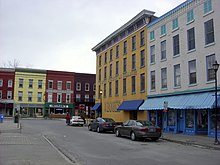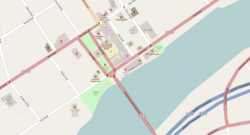Experimental Television Center

Riverow Owego Central Historic District
|
|

Owego Map
|
|
| Formation | 1969 (established), 1971 (founded date) |
|---|---|
| Founder | Ralph Hocking |
| Founded at | Binghamton |
| Extinction | 2011 |
| Merger of | Student Experiments in Television project on the campus of Binghamton University (1969) |
| Type | Non-profit new media art center |
| Location |
|
| Coordinates | 42°06′08″N 76°15′40″W / 42.102103°N 76.261031°WCoordinates: 42°06′08″N 76°15′40″W / 42.102103°N 76.261031°W |
|
Region
|
Owego |
|
Key people
|
Ralph Hocking (Director) Sherry Miller Hocking (Assistant Director) Dave Jones (Systems Consultant) Hank Rudolph (Program Coordinator) |
The Experimental Television Center (ETC) (1969-2011) was a nonprofit Electronic and Media Art center located in upstate New York.
The Experimental Television Center (ETC) was founded in 1971 by Ralph Hocking. The center was the result of the expansion of a media access program that Ralph Hocking established as Professor of video and computer art at Binghamton University in 1969. Some years later, in July 1979, the center was moved from Binghamton to Owego, New York.
The ETC, directed by Ralph Hocking and Sherry Miller Hocking, was devoted to the exploration and development of potential uses of new technology in video and media art. Artists, social, cultural and educational organizations and also interested individuals worked in innovative image processing tools, using all the equipment and the studio facilities with no charge. The Center for more than 40 years had provided a residency program that emphasized the aesthetic experimentation of electronic and media art though new technologies. Artists from around the world and students were trained and worked with rare and unique analog and digital devices for creating video artworks and had access to the media art library of the center. For Ralph Hocking, the center was "a learning place [...], where artists and engineers worked in tandem". In addition, the center organized exhibitions, workshops, cultural events, conferences and provided grand programs to support artists and non-profit media art programs.
In 2011, the Residency and Grants Program of the center was closed. The center’s media arts collection has since been archived and housed at the Rose Goldsen Archive of New Media Art through Cornell University Library’s Division of Rare and Manuscript Collections. The center, through the Video History Project, an on-going research initiative, offers to the public a wealth of often unpublished documents related to the early historical development of video art and community television, with a particular focus on upstate New York during the period 1968-1980. Since the closing of ETC’s art residency program in 2011, Signal Culture -a new nonprofit media arts organization located in the same small village of Owego- aims to support the creation of experimental media.
...
Wikipedia
